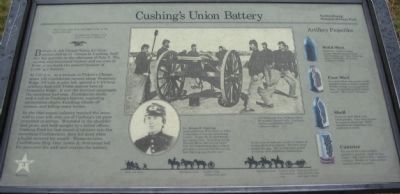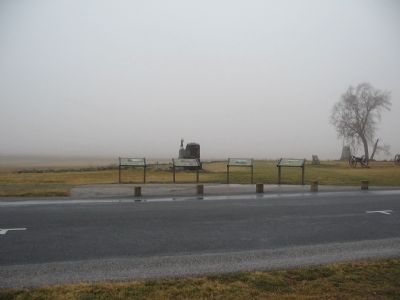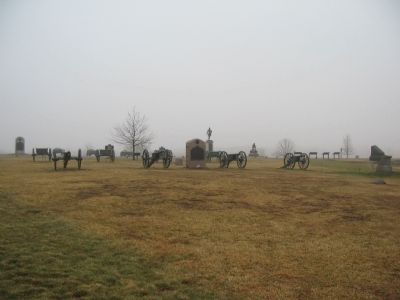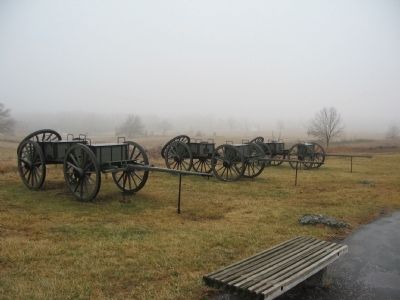Cumberland Township near Gettysburg in Adams County, Pennsylvania — The American Northeast (Mid-Atlantic)
Cushing's Union Battery
July 3, 1863 - Third Day
"No, I stay right here and fight it out, or die in the attempt."
Lt. Alonzo H. Cushing, U.S.A.
4th U.S. Artillery, Battery A
Battery A, 4th United States Artillery, commanded by Lt. Alonzo H. Cushing, held this key position on the afternoon of July 3. The cannon and associated limbers and caissons in front of you mark the general location of Cushing's Battery.
At 1:00 p.m., as a prelude to Pickett's Charge, about 130 Confederate cannon along Seminary Ridge, 3/4 mile to your left, opened a 1-1/2-hour artillery duel with Union cannon here on Cemetery Ridge. It was the heaviest cannonade the continent had seen. Confederate shells took a toll on Cushing's battery, exploding ammunition chests, knocking wheels off cannon, and killing many horses.
By the time enemy infantry reached the stone wall to your left, only one of Cushing's six guns remained in service. Wounded in the shoulder and groin, and held upright by a fellow officer, Cushing fired his last round of canister into the onrushing Confederates, then fell dead when a bullet entered his mouth. Moments later, Confederate Brig. Gen. Lewis A. Armistead led his men over the wall and overran the battery.
Artillery Projectiles
Solid Shot
Solid iron. Used at longer ranges against massed troops, fortifications, and other batteries. Also to fell timber on enemy soldiers in the woods.
Case Shot
Iron shell filled with musket balls sealed in rosin or molten sulphur. Powder charge in core ignited by fuse. Designed to explode before impact. Also called "shrapnel."
Shell
Cast-iron shell filled with black powder. Time fuse ignited by cannon's discharge. Shell exploded into fragments that could kill or maim.
Canister
Tin can filled with iron balls packed in sawdust. Used at close range - 400 yards or less - against infantry. Double or triple canister could be used in a crisis.
Erected by Gettysburg National Military Park.
Topics. This historical marker is listed in this topic list: War, US Civil. A significant historical date for this entry is July 3, 1863.
Location. This marker has been replaced by another marker nearby. It was located near 39° 48.774′ N, 77° 14.134′ W. Marker was near Gettysburg, Pennsylvania, in Adams County. It was in Cumberland Township. Marker was on Hancock Avenue, on the left when traveling north. Located near the "Copse of Trees" on Cemetery Ridge in Gettysburg National Military Park. Touch for map. Marker was in this post office area: Gettysburg PA 17325, United States of America. Touch for directions.
Other nearby markers. At least 8 other markers are within walking distance of this location. Death at the Wall (here, next to this marker); Against All Odds
(here, next to this marker); A Thunderous Duel (here, next to this marker); A Change in Plans (here, next to this marker); 72nd Regiment Pennsylvania Volunteers (a few steps from this marker); First Pennsylvania Cavalry (a few steps from this marker); Major General Alexander Webb (a few steps from this marker); Second Brigade (a few steps from this marker). Touch for a list and map of all markers in Gettysburg.
More about this marker. In the upper center is a photograph showing A Federal gun crew drilling with a 20-pounder Parrott rifle. Cushing's battery used lighter 3-inch ordnance rifles.
In the lower center is a portrait of Lt. Alonzo H. Cushing who graduated from West Point in 1861, a classmate of George Armstrong Custer. At age 22, he died beside his cannon here. According to Cpl. Thomas Moon who served under him, he "looked more like a school girl than a warrior; but he was the best fighting man I ever saw."
At the bottom center is a silhouette display of an artillery section showing the gun and crew, six-horse team, limber with ammunition chest,
another six-horse team pulling a limber with ammunition chest, and finally a caisson with two ammunition cases and a spare wheel. To the rear of each gun stood two teams of horses hitched to limbers. The first team pulled the gun. The second team pulled a caisson with additional ammunition.
Drawings of the projectiles illustrate the sidebar on the right.
Related marker. Click here for another marker that is related to this marker. New Marker At This Location titled "Death at the Wall".
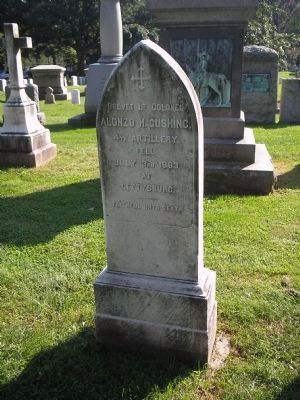
Photographed By Bill Coughlin, September 5, 2009
5. Grave of Lt. Alonzo H. Cushing
Alonzo Cushing is buried in West Point Cemetery at the U.S. Military Academy, next to Maj. Gen. John Buford. The grave of Maj. Gen. Judson Kilpatrick can also be seen in the background. All three played prominent roles in the Battle of Gettysburg.
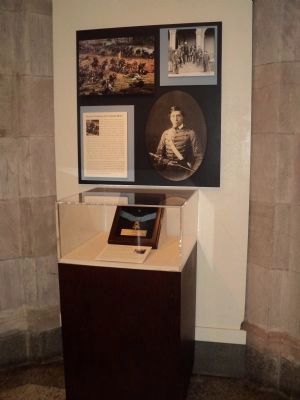
Photographed By Bill Coughlin, April 6, 2015
6. Cushing's Medal of Honor
On November 6, 2014, more than 150 years after being killed at Gettysburg, Lt. Alonzo Cushing was posthumously awarded the Congressional Medal of Honor for his actions during Pickett's Charge. The medal is seen here at West Point Military Academy. Cushing was a member of the Class of June 1861.
Credits. This page was last revised on February 7, 2023. It was originally submitted on February 14, 2009, by Craig Swain of Leesburg, Virginia. This page has been viewed 1,951 times since then and 31 times this year. Last updated on February 23, 2009, by Sherri Watts of Lexington, Kentucky. Photos: 1, 2. submitted on February 14, 2009, by Craig Swain of Leesburg, Virginia. 3. submitted on February 13, 2009, by Craig Swain of Leesburg, Virginia. 4. submitted on February 14, 2009, by Craig Swain of Leesburg, Virginia. 5. submitted on September 6, 2009, by Bill Coughlin of Woodland Park, New Jersey. 6. submitted on April 6, 2015, by Bill Coughlin of Woodland Park, New Jersey.
